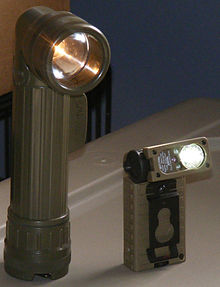Incandescent
Incandescent flashlights use incandescent light bulbs which consists of a glass bulb and a tungsten filament. The bulbs are under vacuum or filled with argon,krypton or xenon. Some high-power incandescent flashlight use a halogen lamp where the bulb contains trace of halogen such as iodine or bromine to improve the life and efficacy of the bulb.
The light output of an incandescent lamp in a flashlight varies widely depending on the type of lamp. A miniature keychain lamp produces one or two lumens. A two D-cell flashlight using a common prefocus-style miniature lamp will produce on the order of 15 to 20 lumens of light [7] and a beam of about 200candlepower. One popular make of rechargeable focusing flashlight uses a halogen lamp and produces 218 lumens. By comparison, a 60-watt household incandescent lamp will produce about 900 lumens.
LED
Developments in light-emitting diodes (LED)s have made practical flashlights that use LEDs instead of conventional light bulbs. LEDs have existed for decades, mainly used as low-power indicator lights. In 1999, Lumileds Corporation of San Jose, California United States, introduced the Luxeon LED, a high-power white-light emitter. This made possible LED flashlights with power and running time better than incandescent lights. The first LuxeonLED flashlight was the Arc LS, designed in 2001[citation needed].
LEDs can be significantly more efficient and use less energy than incandescent lamps. LED flashlights have longer battery lifetimes than incandescent lamps of comparable light output. LEDs are also less fragile than conventional glass lamps.
Some LED flashlights electronically regulate the voltage supplied to the LEDs to stabilize light output as the batteries discharge. By contrast, the light output of non-regulated flashlights declines as battery voltage declines. LEDs also have the advantage of maintaining nearly constant color temperature regardless of input voltage or current, while the color temperature of an incandescent bulb rapidly declines as the battery discharges. Regulated LED flashlights may also have user-selectable levels of output appropriate to a task, for example, low light for reading a map and high output for checking a road sign. This would be difficult to do in an incandescent flashlight since efficacy of the lamp drops rapidly at low output.
LED flashlights may consume 1 watt or more from the battery, producing heat as well as light. Heat dissipation for the LED often dictates that LED flashlightshave aluminum bodies to dissipate heat; they can become warm during use.
Light output from LED flashlights varies even more widely than for incandescent lights. "Keychain" type lamps operating on button batteries, or lights using a single 5 mm LED, may only produce a couple of lumens. Even a small LED flashlight operating on an AA cell but equipped with a power LED can emit 100 lumens. The most powerful LED flashlights produce more than one thousand lumens and may use multiple power LEDs.
LEDs are highly efficient at producing colored light compared with incandescent lamps and filters. Colored LED flashlights are used for signalling, special inspection tasks, forensic examination, or to track the blood trail of wounded game animals. A flashlight may have a red LED intended to preserve dark adaption of vision. Ultraviolet LEDs may be used for inspection lights, for example, detecting fluorescent dyes added to air conditioning systems to detect leakage. Infrared LEDs can be used for illuminators for night vision systems.
HID
Another less common type of flashlight uses a High Intensity Discharge (HID) lamp as the light source. HID is a type of gas discharge lamp that uses a mixture of metal halide salts and argon as a filler.
HID lamps produce more light than an incandescent flashlight using the same amount of electricity. The lamp will last longer and is more shock resistant than a regular incandescent bulb, since it lacks the relatively fragile electrical filament found in incandescent bulbs. However, they are much more expensive, due to the ballast circuitry required to start and operate the lamp.
A typical HID flashlight would have a 35 watt lamp and produce more than 3000 lumens.




No comments:
Post a Comment